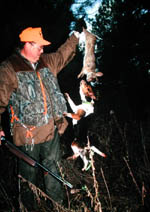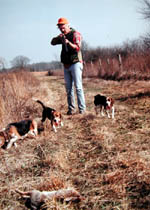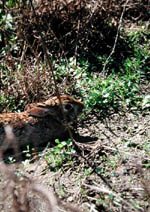
|
Features
|
|
|
|
Books
|
|
|
|
Fun & Games
|
|
|
|
Contact Us
|
|
|
John's Journal... Entry 235, Day 4
HOW TO HAVE A PROPER BUNNY HUNT
Use Hot-Weather Hunting Tactics And Hunt High SpotsAnd Protected Places During Floods
 Editor's
Note: Numbers of outdoorsmen have grown up hunting rabbits, wily creatures
that can teach you many hunting skills. If you live in the South, you
already know the difficulty of hunting rabbits in places with overpopulations
of white-tailed deer. But you can have a proper, successful bunny hunt.
Here's how.
Editor's
Note: Numbers of outdoorsmen have grown up hunting rabbits, wily creatures
that can teach you many hunting skills. If you live in the South, you
already know the difficulty of hunting rabbits in places with overpopulations
of white-tailed deer. But you can have a proper, successful bunny hunt.
Here's how.
When I think of hot-weather hunting for bunnies, Texas, New Mexico and Florida immediately come to mind, since these states home plenty of bunnies. When a drought swept through the South a few years ago, I employed the best hot-weather tactics I learned elsewhere to my own state of Alabama. When most of the countryside looks brown, you'll have a difficult time finding rabbit food. However, often tender, young shoots that provide excellent food for rabbits will grow aroundstock ponds, farm ponds, creeks, rivers and streams. During one dry spell we had in the early fall one year, some friends and I went creek-hunting for bunnies. We wore hip boots, used beagles and hunted down the edges of small creeks that still had flowing water. The man with the dogs waded in the middle of the creeks and took bunnies as they ran or swam across the ankle-deep to knee-deep wanter. Divided evenly on shore, the rest of us took stands and shot the rabbits as they came down the edges of the creeks. If you begin to think like a rabbit and look for essentials they need to survive, you'll discover numbers of rabbit hot spots.
 Hunt
High Spots And Protected Places In The Floods:
Hunt
High Spots And Protected Places In The Floods:
Southerners particularly along with other sections of the country no longer
seem to know what normal weather conditions include because of the unusual
weather we've all had in recent years, including the extremes of droughts
and floods. Either condition is bad for rabbits as well as people. When
a flood hits, people who live along the flood plain must move out of their
houses, go to higher ground and find another way to earn a living in another
place. Although rabbits spend most of their lives within a half-acre of
land, when that land becomes underwater, like the people who live on the
flood plain, the rabbits also have to move to survive. So, pinpoint high-ground
places during flooded conditions that also have food and cover to see
a large number of rabbits. Some years ago, the U.S. Army Corps of Engineers
cleared out a woodlot I hunted every year on the edge of the Tombigbee
River that flowed through west-central Alabama and made it into a spoilage
dump. The engineers dug up this 150- to 200-acre plot and built a dike
around it. Then the Corps pumped the material dredged up from the Tombigbee
River into this spoilage area while building the Tenn-Tom Waterway.
 Each
year dredging this region usually took place in the early spring. Briars
and grass filled this diked spoilage area by late summer and early fall,
making it ideal habitat for both rabbit and deer. When the river flooded,
you couldn't reach the spoilage area except by boat or canoe. However,
because this place had a high bank all around it to keep the dredged material
in, it also kept the water out. Then when flood waters came, this eyesore
became a deer and rabbit hot spot because of the abundant food in the
spoilage area. All along major river systems throughout the country, you'll
see these types of spoilage areas. Although the dikes holding sediment
from the bottom of the river are eyesores, once the grass and briars begin
to grow in these sites, they offer a smorgasbord for cottontails and swamp
rabbits and a honeyhole for the rabbit hunter.
Each
year dredging this region usually took place in the early spring. Briars
and grass filled this diked spoilage area by late summer and early fall,
making it ideal habitat for both rabbit and deer. When the river flooded,
you couldn't reach the spoilage area except by boat or canoe. However,
because this place had a high bank all around it to keep the dredged material
in, it also kept the water out. Then when flood waters came, this eyesore
became a deer and rabbit hot spot because of the abundant food in the
spoilage area. All along major river systems throughout the country, you'll
see these types of spoilage areas. Although the dikes holding sediment
from the bottom of the river are eyesores, once the grass and briars begin
to grow in these sites, they offer a smorgasbord for cottontails and swamp
rabbits and a honeyhole for the rabbit hunter.
TOMORROW: GRASS, CANE THICKETS AND PALMETTO SWAMPS
Check back each day this week for more about HOW TO HAVE A PROPER BUNNY HUNT ...
Day 1 - Hunting Rabbit Food
Day 2 - Hunt Deer To Locate Rabbits
Day 3 - Find Railroad Track and High-Voltage
Rabbits
Day 4 - Use Hot-Weather Hunting Tactics And
Hunt High SpotsAnd Protected Places During Floods
Day 5 - Grass, Cane Thickets and Palmetto
Swamps